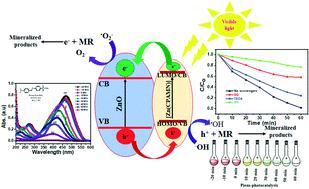当前位置:
X-MOL 学术
›
Environ. Sci.: Water Res. Technol.
›
论文详情
Our official English website, www.x-mol.net, welcomes your feedback! (Note: you will need to create a separate account there.)
A new Zn(II) complex-composite material: piezo-enhanced photomineralization of organic pollutants and wastewater from the lubricant industry
Environmental Science: Water Research & Technology ( IF 5 ) Pub Date : 2021-08-06 , DOI: 10.1039/d1ew00378j Venkateshwar Rao D. 1 , Mahesh Subburu 1 , Ramesh Gade 1 , Manohar Basude 1 , Prabhakar Chetti 2 , Narendra Babu Simhachalam 3 , Penumaka Nagababu 4 , Yadagiri Bhongiri 1 , Someshwar Pola 1
Environmental Science: Water Research & Technology ( IF 5 ) Pub Date : 2021-08-06 , DOI: 10.1039/d1ew00378j Venkateshwar Rao D. 1 , Mahesh Subburu 1 , Ramesh Gade 1 , Manohar Basude 1 , Prabhakar Chetti 2 , Narendra Babu Simhachalam 3 , Penumaka Nagababu 4 , Yadagiri Bhongiri 1 , Someshwar Pola 1
Affiliation

|
In the current work, a ZnO–[Zn(CPAMN)] complex-composite material was used as a piezo-photocatalyst for the mineralization of organic dye pollutants and industrial wastewater. The ZnO–[Zn(CPAMN)] complex-composite material showed higher piezo-photocatalytic activity than a simple complex or ZnO. In contrast, the lower bandgap (2.22 eV) makes it easy for the complex-composite to excite photo-generated species under visible light. Instead, the piezoelectric field initiated from the twisting distortion of [ZnO–Zn(CPAMN)] efficiently enhanced the charge-carrier separation and repositioning. Ultrasonic vibration and visible light radiation applied simultaneously to the complex-composite catalyst mineralized 98% of methyl red (MR) and rhodamine B (RhB) dye solutions during the piezo-photocatalytic process within 60 and 80 min, respectively. The reaction MR constant k of the piezo-photocatalysis process was 50 and 20 times higher than those of sole piezocatalysis and photocatalysis, respectively. The pollutants in industrial wastewater samples were effectively mineralized by over 95% compared to the use of simple piezocatalysis and photocatalysis. Compared to precursor materials such as [Zn(CPAMN)] and ZnO, the significant catalytic activity of the ZnO–[Zn(CPAMN)] complex-composite arose because of heterojunction superiority due to the low rate of recombination of active species and the high surface area.
中文翻译:

一种新型 Zn(II) 复合复合材料:有机污染物和润滑油工业废水的压电增强光矿化
在目前的工作中,ZnO-[Zn(CPAMN)]复合复合材料被用作压电光催化剂,用于有机染料污染物和工业废水的矿化。ZnO-[Zn(CPAMN)] 复合复合材料比简单的复合物或 ZnO 显示出更高的压电光催化活性。相比之下,较低的带隙 (2.22 eV) 使复合材料更容易在可见光下激发光生物质。相反,由 [ZnO-Zn(CPAMN)] 的扭曲变形引发的压电场有效地增强了电荷载流子的分离和重新定位。在压电光催化过程中,分别在 60 分钟和 80 分钟内将超声波振动和可见光辐射同时应用于复合复合催化剂,矿化了 98% 的甲基红 (MR) 和罗丹明 B (RhB) 染料溶液。压电光催化过程的反应 MR 常数 k 分别比单独的压电催化和光催化高 50 倍和 20 倍。与使用简单的压电催化和光催化相比,工业废水样品中的污染物被有效矿化了 95% 以上。与前体材料如 [Zn(CPAMN)] 和 ZnO 相比,ZnO-[Zn(CPAMN)] 复合复合材料具有显着的催化活性,这是由于活性物质的低复合率和高的异质结优势导致的。表面积。与使用简单的压电催化和光催化相比,工业废水样品中的污染物被有效矿化了 95% 以上。与前体材料如 [Zn(CPAMN)] 和 ZnO 相比,ZnO-[Zn(CPAMN)] 复合复合材料具有显着的催化活性,这是由于活性物质的低复合率和高的异质结优势导致的。表面积。与使用简单的压电催化和光催化相比,工业废水样品中的污染物被有效矿化了 95% 以上。与前体材料如 [Zn(CPAMN)] 和 ZnO 相比,ZnO-[Zn(CPAMN)] 复合复合材料具有显着的催化活性,这是由于活性物质的低复合率和高的异质结优势导致的。表面积。
更新日期:2021-08-26
中文翻译:

一种新型 Zn(II) 复合复合材料:有机污染物和润滑油工业废水的压电增强光矿化
在目前的工作中,ZnO-[Zn(CPAMN)]复合复合材料被用作压电光催化剂,用于有机染料污染物和工业废水的矿化。ZnO-[Zn(CPAMN)] 复合复合材料比简单的复合物或 ZnO 显示出更高的压电光催化活性。相比之下,较低的带隙 (2.22 eV) 使复合材料更容易在可见光下激发光生物质。相反,由 [ZnO-Zn(CPAMN)] 的扭曲变形引发的压电场有效地增强了电荷载流子的分离和重新定位。在压电光催化过程中,分别在 60 分钟和 80 分钟内将超声波振动和可见光辐射同时应用于复合复合催化剂,矿化了 98% 的甲基红 (MR) 和罗丹明 B (RhB) 染料溶液。压电光催化过程的反应 MR 常数 k 分别比单独的压电催化和光催化高 50 倍和 20 倍。与使用简单的压电催化和光催化相比,工业废水样品中的污染物被有效矿化了 95% 以上。与前体材料如 [Zn(CPAMN)] 和 ZnO 相比,ZnO-[Zn(CPAMN)] 复合复合材料具有显着的催化活性,这是由于活性物质的低复合率和高的异质结优势导致的。表面积。与使用简单的压电催化和光催化相比,工业废水样品中的污染物被有效矿化了 95% 以上。与前体材料如 [Zn(CPAMN)] 和 ZnO 相比,ZnO-[Zn(CPAMN)] 复合复合材料具有显着的催化活性,这是由于活性物质的低复合率和高的异质结优势导致的。表面积。与使用简单的压电催化和光催化相比,工业废水样品中的污染物被有效矿化了 95% 以上。与前体材料如 [Zn(CPAMN)] 和 ZnO 相比,ZnO-[Zn(CPAMN)] 复合复合材料具有显着的催化活性,这是由于活性物质的低复合率和高的异质结优势导致的。表面积。



























 京公网安备 11010802027423号
京公网安备 11010802027423号